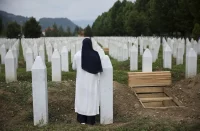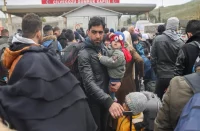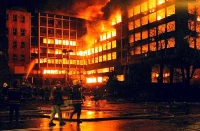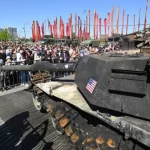There are many American and other Western journalists and political analysts who have been severely criticizing U.S. policy in the Balkans during the last 30 years but especially in the 1990s during the time of the brutal destruction of ex-Yugoslavia followed by the bloody civil war primarily because the U.S. administrations backed Muslim radical extremists in Bosnia-Herzegovina, Kosovo-Metochia, and North Macedonia; the radical fundamentalists who allowed the creation of the strong Osama bin Laden’s “al-Qaeda” Islamic extremist network in the Balkans that is functioning up today. Such U.S. foreign policy in the Balkans, however, decreased the real chances for any comprehensive struggle to combat international terrorism.
The critique is put on the fact that from 1992 (the beginning of the Bosnian-Herzegovinian civil war) to 1999 (end of the Kosovo crises), Osama bin Laden and the U.S. administration of President Bill Clinton supported, in fact, the same Islamic extremists in Bosnia-Herzegovina, Kosovo-Metochia, Albania, and North Macedonia (Islamic Bosnian-Herzegovinian Government of Alija Izetbegović, terrorist Albanian Kosovo Liberation Army, the Albanian Government in Tirana, and the Liberation National Army of Albanians in North Macedonia). Nonetheless, the result of such policy is that the Balkans became one of the strongest “al-Qaeda”’s a stronghold in the World – in fact, one of the most important centers where from Osama bin Laden and his organization have been planning the terrorist actions against the West and Western supporters.

Undoubtedly, a terrorist Islamic extremist organization “al-Qaeda” has been expanding its own network of operatives in the Muslim-controlled Balkan territories since the beginning of the 1990s. This fact suggests to the Western mass media to conclude that the U.S. policy in the Balkans finally failed because in Bosnia-Herzegovina, Kosovo-Metochia, Albania, and North Macedonia there is a big danger that Osama bin Laden’s supporters and their like-minded Islamic fanatics (the ISIS, etc.) already fomenting Iran’s Khomeini-style Islamic revolution. They, moreover, have strong financial support to organize small groups of Islamic radicals who are intent on provoking general instability or inciting terror actions not only in the region but in the U.S. and West Europe as well. About this problem, for instance, BBC made a documentary movie in 2015 under the title Bosnia: Cradle of Modern Jihadism? with a short official description of the movie:
“20 years ago in the civil war in Bosnia, hundreds of Arab jihadists came to join Bosnian Muslims fighting against their neighbours the Serbs and Croats. Grouped into secret fighting units in Central Bosnia, this was the first time in centuries Jihad had been fought against a Western, Christian enemy. Two decades later Bosnia is still reaping the consequences. In the past month, ISIS declared the Balkans the next front of Jihad – and in remote mountain villages extremists are flying the ISIS flag. Mark Urban returns to Bosnia and discovers how secular Bosnian society has been infiltrated by a militant Islamism which operates to this day”.[1]
In the last two decades both Osama bin Laden’s “al-Qaeda,” Islamic terrorist organization and the ISIS (or ISIL/DAESH) are forging strong ties with indigenous Muslim activists, such as, for instance, the former war-time Bosnian-Herzegovinian President Alija Izetbegović (who in WWII served in notorious Muslim SS Hanjar Division established by Heinrich Himmler in Bosnia-Herzegovina) and radical military groups as the Kosovo Liberation Army and its branch in North Macedonia which north-western territories are populated by Muslim Albanians who during the 1998−1999 Kosovo War actively supported the Kosovo Liberation Army.
According to American Gordon N. Bardos, assistant director of the Harriman Institute at Columbia University, the U.S. provided significant financial, military (in the form of arms, training, and intelligence), and political support to the Islamic army forces commanded by Bosnian-Herzegovinian President Alija Izetbegović (who, btw, on the presidential elections in 1990 in Bosnia-Herzegovina did not get the majority of the votes). In 1992, the U.S. House of Representatives’ Task Force on Terrorism and Unconventional Warfare report stated that this Muslim Bosnian war-time leader was best known for his activities as an Islamic radical dissident (who wrote and signed the Islamic radical Islamic Declaration in 1970 according to it “there is no peace or coexistence between Islamic faith and non-Islamic social and political institutions”) and was jailed twice in former Yugoslavia for his Islamic radicalism, links with other Islamic militant movements, such as those affiliated with Ayatollah Khomeini in Iran, for example. During the Bosnian-Herzegovinian civil war in 1992−1995, Alija Izetbegović’s Government invited radical Muslim fighters (“mujahidin”) from Afghanistan, Algeria, Egypt, Iran, and Jordan to fight against Croats and Serbs.[2] These radical Islamic fighters, among them there were and members of “al-Qaeda”, were organized within the “7th Muslim Brigade” (of the Bosnian-Herzegovinian Army) that numbered some 7.000 soldiers.[3]
In the course of the war, this “mujahidin” Bosnian-Herzegovinian army fought in Central Bosnia and became accused by the International War Crime Tribunal for the Former Yugoslavia in the Hague of some of the most extreme war crimes committed by Alija Izetbegović’s military forces including and those in the safe-area of Srebrenica under the command of a war criminal Naser Orić. Today, it is well known that Osama bin Laden was the main organizer and financial sponsor of the transportation of several thousands of the radical Islamic fighters from Arabic states to Bosnia-Herzegovina (and later to Kosovo-Metochia and North Macedonia).
According to the Yugoslav Government’s sources, the majority of those “mujahidin” from Bosnia-Herzegovina after the Dayton Peace Agreement was signed (on November 21st, 1995) went to Kosovo-Metochia and North Macedonia, but some 1.500 of them still left in Central Bosnia’s military training camps (especially in the Zenica district). The Yugoslav (Serbian-Montenegrin) Government stated that there were after the 1999 Kumanovo Peace Agreement some 3000 Islamic military fanatic soldiers in Kosovo-Metochia’s training camps and that only in the American zone in Kosovo-Metochia there were 50 “al-Qaeda” members.

The elite Islamic extremist military unit established in Bosnia-Herzegovina was “El Mujahid” (founded in Central Bosnian-Herzegovinian city of Zenica in August 1993). There is even a videotape on which Bosnian-Herzegovinian Muslim General Mahmuljin is stating that the soldiers of Osama bin Laden’s “al-Qaeda” presented 28 Serb soldiers’ heads to Alija Izetbegović and those 28 Serb soldiers’ heads have been sent as a gift to Iran. The same videotape, which is showing how “al-Qaeda” soldiers are killing Serb prisoners of war and how Bosnian-Herzegovinian President Alija Izetbegović is saluting the “mujahidin” soldiers, could be taken from any bigger videotape shop in Central Bosnia in the 1990s.[4]
Osama bin Laden was a prominent supporter of the Izetbegović’s regime in Bosnia-Herzegovina, and, according to the Bosnian-Herzegovinian writer Senad Pećanin, Bosnian-Herzegovinian Muslim Government had provided in 1993 passports of the Republic of Bosnia-Hercegovina to Osama bin Laden and several of his associates. German journalists, Erich Follath and Günther Latsch (in Der Spiegel, September 15th, 2001) claimed that Osama bin Laden visited Sarajevo (capital of Bosnia-Herzegovina) in 1993 and showed his Bosnian-Herzegovinian passport to the foreign reporters. Radio Free Europe (on September 22nd, 1999) gave information that the Bosnian-Herzegovinian Government in Sarajevo was issuing Bosnian-Herzegovinian passports to the members of “al-Qaeda” as late as 1997.
It is known that the American Central Intelligence Agency (the CIA) became informed that the Turkish secret police arrested one of Osama bin Laden’s associates in 1999 who had traveled with Bosnian-Herzegovinian passport on the charge for terrorist activities (according to the Agence France-Presse (the AFP), he was one of the most important Osama bin Laden’s aides) and that Ahmet Ressemi, a member of “al-Qaeda” was arrested with Bosnian-Herzegovinian passport as well as on December 14th, 1999 on the U.S.-Canadian border in a car carrying nitroglycerin and other bomb-making materials. Ahmet Ressemi became as well as accused of the preparation of the explosion at the Los Angeles International Airport in 1996.
The information that Osama bin Laden build a strong network of his terrorist organization in Central Bosnia-Hercegovina was a signal for NATO troops in Bosnia-Herzegovina to occupy one of the several terrorist camps in this country which was located in the vicinity of the city of Fojnica. The New York Times (The NYT) reported on June 26th, 1997 that some of the Islamic radical terrorists arrested for the 1996 attack on the Khobar Towers building in the capital of Saudi Arabia (Riyadh) when 19 U.S. military personnel were killed, belonged to the “al-Qaeda” organization fighting in Bosnia-Herzegovina on the side of Alija Izetbegović’s military forces (the “Green Berets”). Finally, the New York Magazine on February 6th, 2000 uncovered three plots by the “al-Qaeda” branch of Bosnian-Herzegovinian Islamic extremists to attack several civil targets in West Europe in 1999.
 Osama bin Laden continued to spread his organizational network in Bosnia-Herzegovina what compelled the OUN (in fact, NATO) peacekeeping troops in this country to force local Bosnian-Herzegovinian police forces to arrest 3 Osama bin Laden’s associates in July 2001 in Sarajevo. However, regardless that after the attacks on September 11th, 2001 on the World Trade Center and the Pentagon, a dozen of “al- Qaeda” and other Islamic militant terrorists have been arrested in Bosnia-Herzegovina by NATO troops, the members of Osama bin Laden’s secret terrorist organization still consider Bosnia-Herzegovina as safe territory for their activities. This is confirmed by Bosnian-Herzegovinian Minister of Interior, Muhamed Bešić, who stated that around 70 members of the “al-Qaeda” organization were attempting to come from Afghanistan to Bosnia-Herzegovina after the U.S. army destroyed the main Osama bin Laden’s refugee camp in a military air-strike campaign after the September 11th, 2001.
Osama bin Laden continued to spread his organizational network in Bosnia-Herzegovina what compelled the OUN (in fact, NATO) peacekeeping troops in this country to force local Bosnian-Herzegovinian police forces to arrest 3 Osama bin Laden’s associates in July 2001 in Sarajevo. However, regardless that after the attacks on September 11th, 2001 on the World Trade Center and the Pentagon, a dozen of “al- Qaeda” and other Islamic militant terrorists have been arrested in Bosnia-Herzegovina by NATO troops, the members of Osama bin Laden’s secret terrorist organization still consider Bosnia-Herzegovina as safe territory for their activities. This is confirmed by Bosnian-Herzegovinian Minister of Interior, Muhamed Bešić, who stated that around 70 members of the “al-Qaeda” organization were attempting to come from Afghanistan to Bosnia-Herzegovina after the U.S. army destroyed the main Osama bin Laden’s refugee camp in a military air-strike campaign after the September 11th, 2001.
However, three factors are limiting the threat posed by the Islamic extremists and radical fundamentalists in Bosnia-Herzegovina including today the ISIS as well:
- The Bosnian-Herzegovinian Muslim population is in essence secular, at least in comparison to the Muslim population in some Arab countries, and for that the extremist Islam is of little attraction for the majority of the local population in Bosnia-Herzegovina.
- The existence of an action-oriented civil society among the native Muslim inhabitants of Bosnia-Herzegovina.
- The presence of NATO troops in Bosnia-Herzegovina.
Nevertheless, and unfortunately, according to the American scholar Srđa Trifković, far from enhancing peace and regional stability, Western policies in the Balkans continue to encourage seven distinct but interconnected trends which are making stronger the activities of the Islamic radicals:
- Pan-Islamic agitation for the completion of an uninterrupted Transverse (the Balkan Islamic “Green Corridor”) by linking of its as yet unconnected segments.
- The destabilization of Bosnia-Herzegovina is resulting from constant Muslim demands for the erosion of all constitutional prerogatives leading to the abolition of the Republic of Srpska.
- Growing separatism among Muslims in the Raška (Sanjak) region of Serbia, manifest in the demand for the establishment of an “autonomous” Sanjak region.
- Continuing intensification of greater-Albanian aspirations against North Macedonia, Montenegro, Greece, and rump-Serbia.
- Further religious radicalization and ethnic redefinition of Muslims in Bulgaria, leading to demands for territorial autonomy in the Rhodope region.
- The ongoing spread of Islamic agitation, mainly foreign-financed, through a growing network of mosques, Islamic centers, NGOs, and “charities” all along the route of the Balkan Islamic “Green Corridor”.
- Escalation of Turkey’s regional ambitions and Ankara’s quiet encouragement of all of the above trends and phenomena.[5]
Reposts are welcomed with the reference to ORIENTAL REVIEW.
[1] Link: https://www.youtube.com/watch?v=M6QIopgwuIU&list=PL999EB6ACC07FC959&index=3
[2] It is obvious, 17 years later, that Alija Izetbegovic meant business. President Clinton was still in the White House when a classified State Department report warned that the Muslim’s controlled parts of Bosnia-Herzegovina were a safe haven for Islamic terrorism. It warned that hundreds of foreign mujahidin, who had become Bosnian-Herzegovinian citizens and remained there after fighting in the war, presented a major terrorist threat to Europe and the United States. Among them were hard-core terrorists, some with ties to Osama bin Laden, protected by the Muslim Government in Sarajevo. Confirmation came in November 2001 when two Bosnian-Herzegovinian passports were found in a house vacated in Kabul by the fleeing Taliban. The findings were summarized by a former State Department official that Bosnia-Herzegovina was “a staging area and safe haven” for Islamic terrorists.
[3] Mujahidin (“holy warriors”) is a term usually applied to a coalition of different Islamic groups which are formed in the early 1980s in political-military response to the Soviet invasion of Afghanistan on December 24th, 1979. They have been aided by generous arms supplies from the U.S. administrations via Pakistan. Their guerrilla warfare finally led to the Soviet armed forces’ withdrawal from Afghanistan by February 1989. In 1992, the Communist Government in Afghanistan was ultimately changed, but shortly after the establishment of an Islamic state, on May 6th, 1992, the fragile political coalition was broken. Alliances between the different factions of the mujahidin have been changing constantly while Afghanistan was in the conditions of political anarchy. Out of such chaos emerged the Northern Alliance and the Taliban, which during the 1990s managed to bring most of the country under its control.
[4] The core of Osama bin Laden’s Balkan network were the veterans of the “El Mujahid” brigade of the Bosnian-Herzegovinian Muslim army (the Army of Bosnia-Herzegovina). It included volunteers from all over the Islamic world. The unit was distinguished by its spectacular cruelty to the Christians (Serbs and Croats), including the decapitation of prisoners to the chants of Allahu-akbar. The “El Mujahid” was the nursery from which an international terrorist network spread to Europe and North America. After the end of the Bosnian-Herzegovinian war in November 1995, many Muslim volunteers, however, remained in Bosnia-Herzegovina. The Bosnian-Muslim Government in Sarajevo circumvented the 1995 Dayton rules by granting Bosnian-Herzegovinian citizenship to several hundred Arab and other Islamist volunteers. Less than a year after the war ended, they were well established, having taken over Serbian-owned properties and married local women, sometimes by force. They and other Bosnian-Herzegovinian veterans went on to perpetrate murder and mayhem in many countries in Europe, North Africa, the Middle East, Asia, and the U.S.
[5] Srđa Trifković, The Green Corridor: Myth or Reality? Implications of Islamic Geopolitical Designs in the Balkans, 2009.














Don chisciotte sotirovic in action
Forever in the action for the truth and justice in history and politics
No you are a serbian troll
If Albanian bot is saying well it is ok
Rezi vlore is a real Albanian bot and troll!! Thank you Prof. Sotirovic for accurate articles on Balkan history and politics!